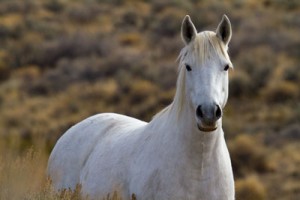The History of America’s Wild Horses
In 1971, Congress unanimously passed the Wild Free-Roaming Horse and Burro Act, which deignated 51 million acres in the American West for protection of wild horses and burros, declared that “wild horses and burros are living symbols of the historic and pioneer spirit of the West; that they contribute to the diversity of life forms within the Nation and enrich the lives of the American people; and that these horses and burros are fast disappearing from the American scene.” The Bureau of Land Management (BLM) and the U.S. Forest Service (USFS) were appointed to implement the Act. Most herd areas are under BLM jurisdiction.
 Unfortunately, over the past 40 years, the 51 million acres has been reduced to less than 32 million.
Unfortunately, over the past 40 years, the 51 million acres has been reduced to less than 32 million.
In 2001, after decades of failed herd management policies, the BLM obtained a 50% increase in annual budget to $29 million for implementation of an aggressive removal campaign.
In 2004, the 1971 Act was surreptitiously amended, without so much as a hearing or opportunity for public review, opening the door to the sale of thousands of wild horses to slaughter for human consumption abroad.
The U.S. Bureau of Land Management is charged with overseeing the estimated 33,000 wild horses that roam freely in 10 Western states. About half of those are in Nevada.
The current situation is the result of a long history of failed policies, land allocation issues, and an intricate money trail. The BLM and the USFS, among others, are responsible for managing the nation’s public lands and are foremost the managers of wild horses and burros. Their responsibilities also include issuing public land grazing permits to cattle ranchers. These grazing permits cover limited areas of public land that are available for lease. So, for every wild horse removed from a grazing permit allotment, a fee-paying cow gets to take its place, and a public land rancher gets the benefit of public land forage at bargain rates. This is the number one reason wild horses are removed from public lands.
The fact is that the 1982 National Academy of Sciences report and two General Accounting Office reports have countered key points in BLM’s premise for its current herd reduction campaign. These government-sanctioned documents concluded that: (i) horses reproduce at a much slower rate than BLM asserts, (ii) wild horse forage use remains a small fraction of cattle forage use on public ranges, (iii) “despite congressional direction, BLM did not base its removal of wild horses from federal rangeland on how many horses ranges could support,” and (iv) “BLM was making its removal decisions on the basis of an interest in reaching perceived historic population levels, or the recommendations of advisor groups largely composed of livestock permittees.”
What’s Happening Now:

With the continuing wild Mustang roundups by the BLM, scheduled through the end of 2012, the Wild Mustangs are on the path of extinction.
There are now more wild horses in government holding pens than remain in the wild, with many of the remaining herds managed at population levels that do not guarantee their long-term survival. Still, the round-ups continue.
Over the past forty years, federal law enacted by the people on behalf of their wild horses has been ignored. No strategic plan to keep viable herds of wild horses on public lands was ever developed.
What You Can Do:
American Wild Horse Preservation Coalition is calling for a Congressional inquiry into the government’s wild horse management policies, and coordinating a grassroots campaign in support of:
- A suspension of roundups in all but verifiable emergency situations while the entire BLM wild horse program undergoes objective and scientific review;
- Higher Appropriate Management Levels (AML) for wild horses on those rangelands designated for them;
- Implementation of in-the-wild management, which would keep wild horses on the range and save taxpayers millions annually by avoiding the mass removal and stockpiling wild horses in government holding facilities.
Click here to see a PDF regarding the problems and solutions to keeping our American Wild Horses wild.
